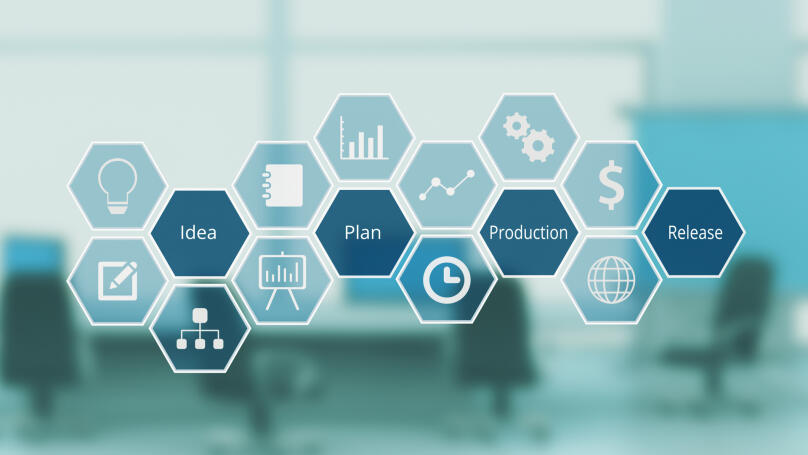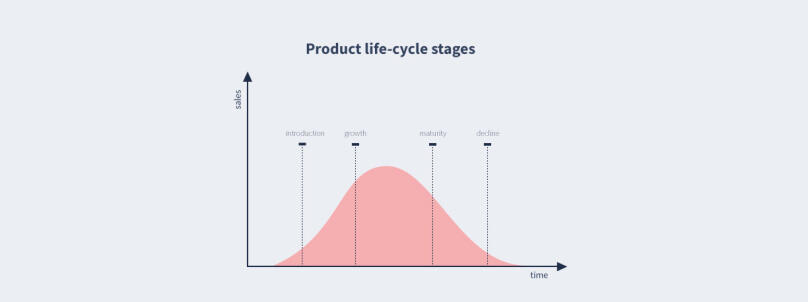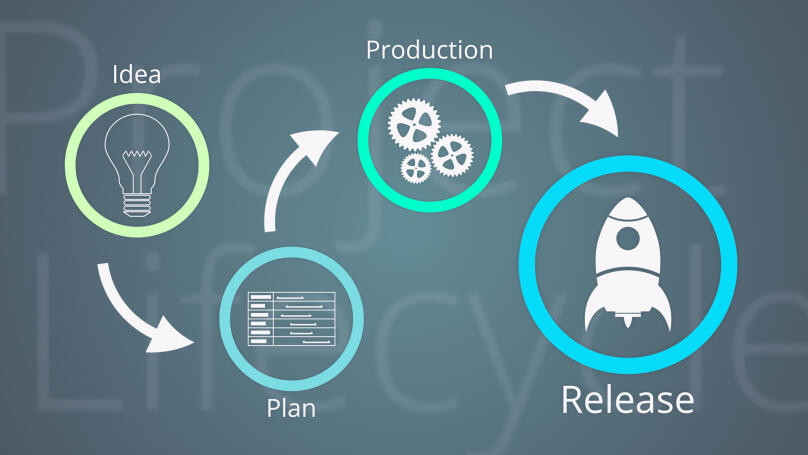Product Life Cycle
What is Product life cycle?

The product life cycle (PLC) is a succession of stages that every product released goes through starting from the moment of its appearance in the market to the moment of leaving it (if its production or realization is over). Simply put, the product life cycle is the period of the product's existence and availability.
The product life cycle is actively used in marketing to build an advertising strategy, as each LCD stage has its own distinctive features that can be used for promotion. Each stage also has its own specific goals and objectives.
The duration of a cycle can be as long as a few days or decades. Typically, this duration depends on:
- the industry in which the product was produced;
- the economy of a country (including trends and inflation level);
- market specifics;
- specifics of the product.
For example, the life cycle of medicines is many years, while the one of a certain phone model is only 2 to 3 years.. Even more extreme are products in the sensation category, which live only a few weeks.
Product life cycle theory
The product life-cycle theory was first proposed in 1966 by the American economist Raymond Vernon. The researcher tried to identify a model for the development of all world trade. To do this, he took the life cycle of all living organisms as a pattern.
According to Vernon's theory, in the early stages of the life cycle of a product, all work on this product is concentrated in the market segment in which it was launched. Over time, however, the product moves further away from this segment and beyond it. Finally, the product enters the international market and is imported.
Product life cycle concept
The concept of the product life cycle in the traditional view was developed by the American economist Theodore Levitt in 1965. According to his vision, replacing one product with another, more modified and meeting new needs of the society, is always inevitable. So replacing the old with the new illustrates the concept of a life cycle. The basic thesis of the theory is that any product, no matter how popular it is, will one day leave the market.
The modern market is characterized by a dynamic and growing variety of products, as well as the regular appearance of new materials and methods of production. Under these conditions, the product life cycle model is used to "prolong the youth" of the product by introducing new technologies into production on time and following trends. So, if the goods are constantly improved, the life cycle lengthens.
Product life cycle stages

What stages does the life cycle consist of? There are four stages in the traditional cycle: introduction, growth, maturity and decline. Typically, each product goes through all stages of the product life cycle. They can be seen on the graph:

Stage 1. Introduction
At this stage of the product life cycle, the product is put to market. This stage has the following characteristics:
- instability and the inability to predict future product development;
- the marketing strategy oriented on informing and heating the audience; the audience gets acquainted with the brand;
- high advertising costs;
- high production costs for low production volumes;
- minimum profit; sometimes it's lower than costs;
- slow sales growth.
Stage 2. Growth
The product is beginning to gain a foothold in the market and has already attracted enough audience attention for further growth. The second stage of the product life cycle has the following characteristics:
- rapid growth in sales;
- increased profits and reduced costs, as well as lower production costs, given the increased volume of production;
- stable prices for materials and the product itself;
- the marketing strategy is switching from attracting an audience to engaging one;
- high marketing costs;
- fierce competition with other companies.
Stage 3. Maturity
The product has gained a stable market position and an ongoing audience. This stage has the following features:
- demand is at its peak, but sales are declining due to a market glut;
- the market is being segmented and the audience is expanding;
- new audience requests, not previously addressed, are being met;
- lower product price and lower profit;
- the key objective of the company is to retain current customers;
- increased market share by gaining competitive advantage;
- partnerships and collaborations are created;
- there is an opportunity to go international.
Stage 4. Decline
At this stage, those who needed the product had already bought it. The company is starting to step down and lag behind those companies that are in the introduction or growth stage. The following signs can indicate the beginning of the stage of decline:
- slow but continuous drop in product demand;
- lower production;
- withdrawal of funding and budget cuts;
- shrinking audience;
- the company is concentrated on the residual market;
- obsolescence of used technologies and product properties;
- the increase in marketing costs does not yield tangible results.
Typically, the decline is followed by death e.g. companies close and leave the market.
Product life cycle management

Different phases of the product lifecycle involve different approaches to marketing and promotion. The main goal of the company at any stage is its rational extension. Lifecycle management allows you to "brake" the process.
Managing the introduction stage
The cream skimming strategy
Its essence is to set the maximum price on the product and to invest the entire budget into advertising and media. IN this case, the company's marketing goal is to convince the audience of the benefits and advantages of the product as quickly as possible. The highest unit price allows you to get instant profit and quickly recoup all the costs. This strategy is best used when:
- the product is revolutionary and unprecedented, therefore, 90% of the market is unfamiliar with it;
- the goods belong to the luxury class, which makes people with a need for "elitism" willing to pay a high price;
- the company is trying to take top positions in a highly competitive niche.
Rapid market entry strategy
The product is priced at the lowest price and is strongly advertised as a novelty. This way the product penetrates the market in the shortest time and immediately conquers a large segment of the audience. This strategy is appropriate if:
- the company enters a large and competitive market;
- the target audience is focused on the low price;
- the company has minimized production costs.
Managing the growth stage
To extend the life cycle of a new product on the growth stage, a company can:
- continuously improve the quality of goods by introducing new features and functions;
- introduce new models and expand the range;
- enter other market niches;
- periodically change sales and advertising channels;
- make forming consumer habits and creating a pool of loyal customers the main advertising tasks;
- release budget options or reduce the cost of the main product.
Managing the maturity stage
At this stage, companies tend to focus on the production of the goods that are most in-demand and generate the most profit, abandoning the goods with low or medium demand. This strategy is fundamentally wrong if the company wants to prolong the maturity stage. It should also:
- continue to gain the trust of the customers who are not yet using the product;
- look for opportunities to enter new market segments;
- poach competitors' customers;
- continue to improve the product quality and create its alternate versions;
- add new features and accessories to your product, making it more versatile and personalized.
Managing the decline stage
It is important to identify "ageing" products in time and to take steps to slow down their ageing process. There are five strategies to do this:
- Attracting new sources of financing to strengthen market position.
- Focus on "resource conservation" until the situation in the market and in the company stabilizes.
- Refocusing on the most profitable consumers and avoiding financing small segments.
- Investing for the long term and avoiding short-term investments.
- Reducing the production of goods and selling the company's shares.























